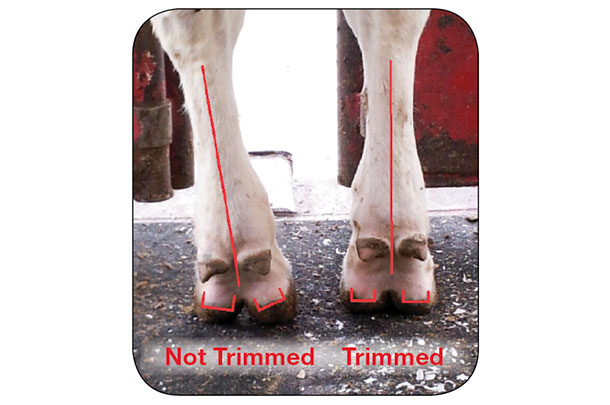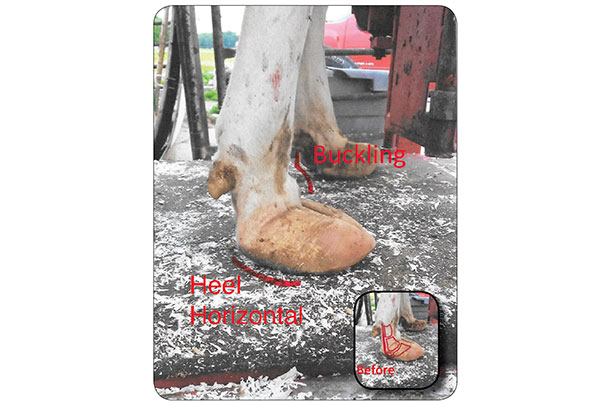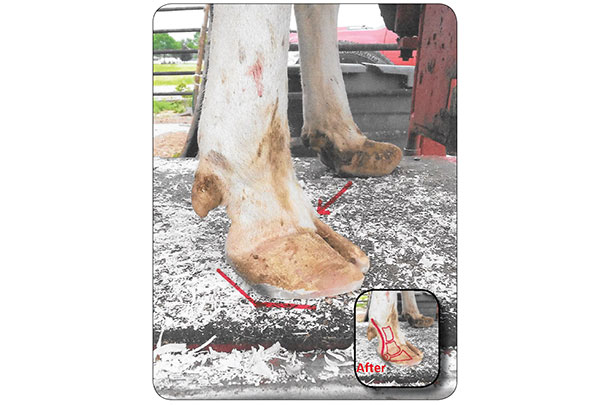When it comes to hoof trimming, are you getting precision balance – or are you just getting smaller hooves? Hoof comfort has a major effect on milk production, reproduction, longevity, cull rate and overall herd health.
With the impact hoof health has on your herd, you simply cannot afford anything but precision-balanced hoof trimming. The dairy cow’s weight-to-surface ratio creates a challenge, particularly for cows confined to concrete flooring. Therefore, it is our responsibility to provide them with comfortable and stable footing.
Why balanced feet matter
Every trim has an impact on the angle of the hoof from front to back and side to side, which is why it is important that the hoof trimmer takes the time and care to ensure a properly balanced trim for each foot. Dairymen should note that when the trimmer is done with a foot, a pile of hoof chips does not necessarily mean the hoof is balanced.
Balancing the hoof is a critical aspect of the trimmer’s job, and when done correctly and at regular intervals, it can improve the dairyman’s bottom line. You see, a balanced hoof wears evenly, which reduces the likelihood and severity of a hoof lesion. Further, a hoof that is properly balanced is more likely to make a full recovery in the event the cow falls victim to a lesion.
Even in well-managed facilities, lesions can occur as a result of outside stress factors as cows are overcrowded and pushed to their thresholds for milk production. It is much easier to prevent hoof problems or reduce their risk of severity than to repair them.
As a trimmer, I have noticed how stresses impact hoof health. Most often, I see this resulting from calving, heat stress and feed changes or unbalanced nutrition. Such stress factors can be difficult to avoid, which is why maintaining a well-balanced hoof will help a cow get through her rough period without incident. An unbalanced hoof, however, will likely have a pinch point, causing damage to the corium or the white line. The result is a lesion that causes the cow pain and the dairyman money.
What does a balanced hoof look like?
When I trim a foot, my goal is not to remove as much hoof as possible but rather to focus on an end result that gets the cow standing and walking properly.
From the rear view, the axial and abaxial wall (inner and outer hoof wall) should be perpendicular to the ground. This is not done by using a grinder on either of these walls, it is done by pitching the sole of each hoof claw and requires “an eye” and precise care. This is very similar to the front-end alignment of a car (Photo 1).

Balancing the pedal bone from front to back requires the correct length of toe and pitch from heel to toe. When this is not done correctly, it oftentimes results in either sole ulcers or toe ulcers, and sometimes long-term damage is caused, resulting in chronic lameness.

Proper balanced trimming can make a big difference in a dairy herd. I have seen farms gain 10 pounds of milk production and go from buying replacement animals to selling springing heifers simply because they adopted a hoof-trimming program that focused on balance.
With an additional 10 pounds of milk per 100 cows, that adds up to more than $40,000 annually.

In times of low milk prices, farms simply cannot afford to miss opportunities for maximum performance out of each cow. To achieve these types of results, it is important to ensure every trim is being done to the highest standard.
Ferrari does not use speed in their production to achieve high performance; they use extreme precision to achieve speed and performance. This needs to be considered when trying to get the most out of our dairy cows. Every farm and every cow has different trimming needs.
Some cows need more trimming while others need less work, but when a precise, balanced trim is performed on a routine basis, most cows will only need a slight touch-up to maintain balance. Maintaining a herd that only needs fine tuning to obtain optimum results is well worth the effort. PD
Aaron LaVoy is with Midwestern Hoof Care LLC. Email Aaron LaVoy.
PHOTO 1: Like the front alignment of a car, a cow’s front feet need to be balanced so that her inner and outer hoof walls are perpendicular to the floor.
PHOTO 2: Inset: What you cannot see from the outside is the pedal bone inside the foot. At this angle, all of her weight is on the back of that bone, making the cow prone to sole ulcers and chronic lameness. Main Photo: You can see here that overgrowth is causing this cow’s foot to buckle between her toes.
PHOTO 3: Inset and Main Photo: Balancing the foot eliminates buckling and corrects the angle of the pedal bone from heel to toe. Photos provided by Aaron LaVoy.






